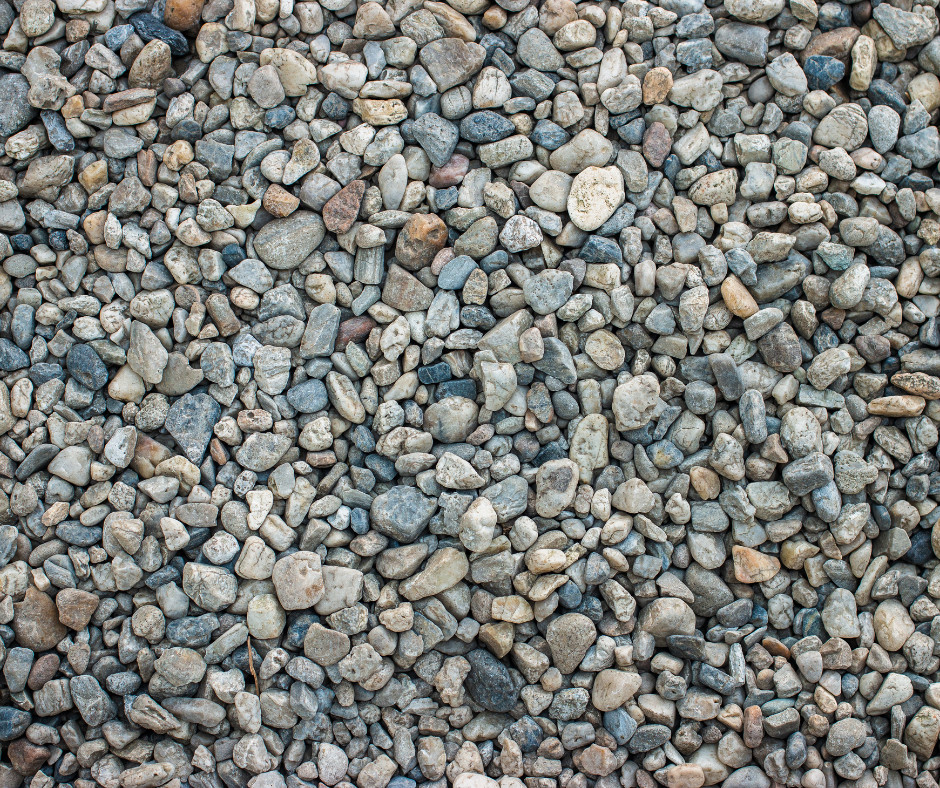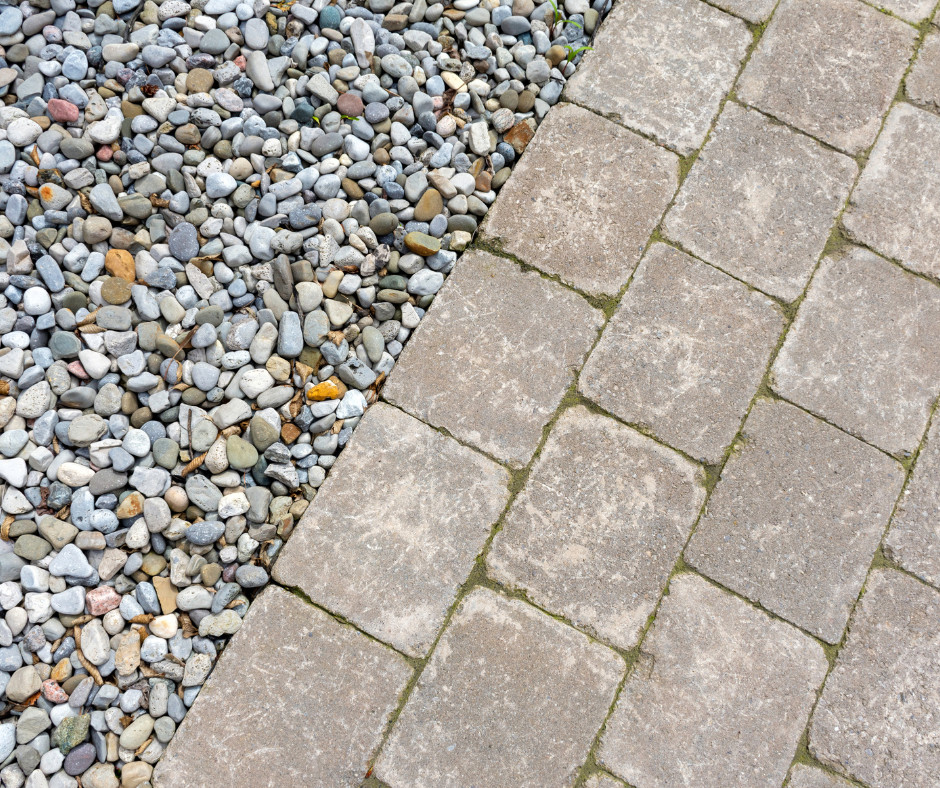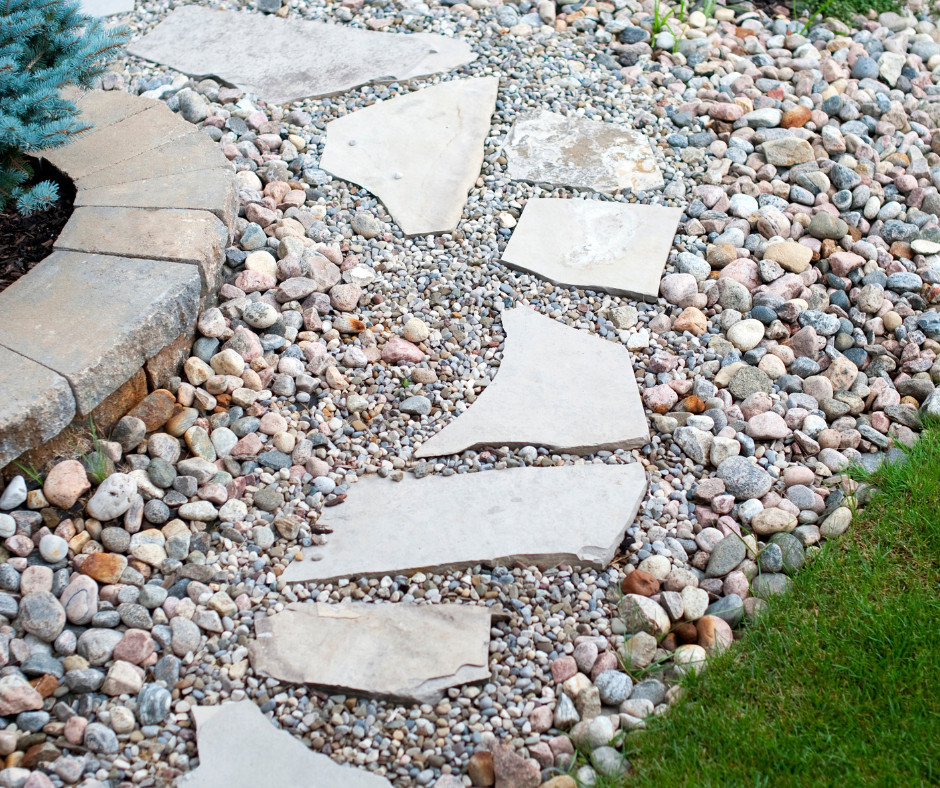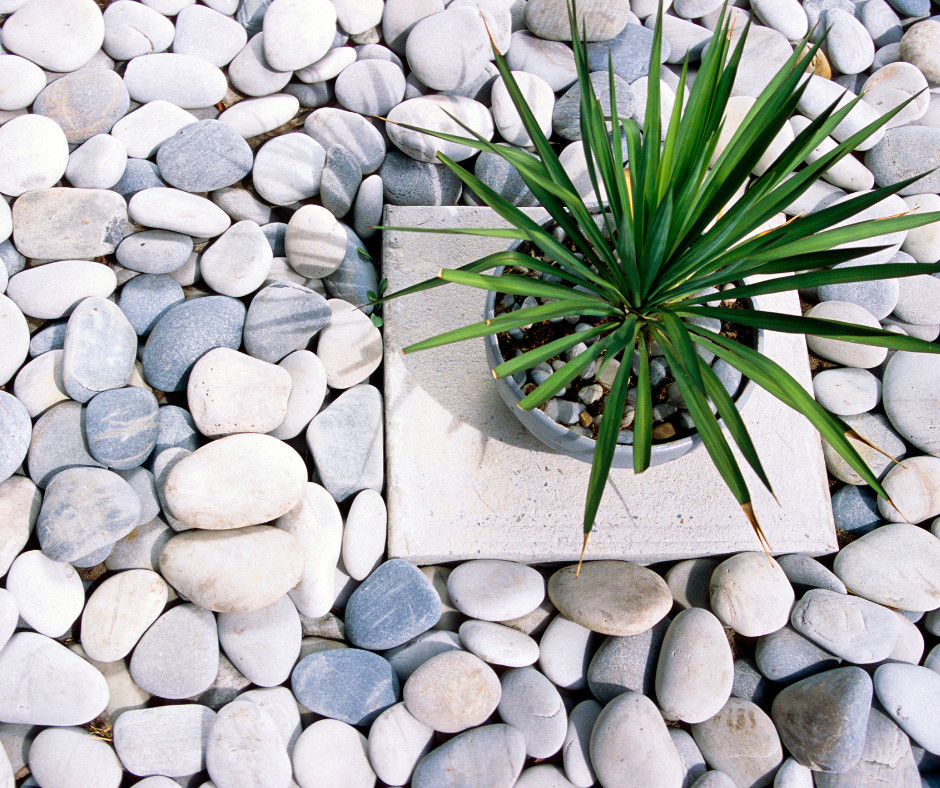Getting rid of old landscape rock can feel like a Herculean task, but it doesn’t have to be. At rockscapes.net, we’ll guide you through practical and eco-friendly methods to remove those unwanted stones, paving the way for your dream outdoor space with fresh landscaping ideas and designs. Whether it’s repurposing, recycling, or responsible disposal, discover how to transform your yard into a stunning rock garden or a serene green oasis using alternative ground cover materials and innovative landscape design.
1. How Do I Assess The Landscape Rocks I Need To Get Rid Of?
Determining the type and amount of rock you have is the initial step. Are you dealing with hefty boulders, smaller rocks, or a combination? Knowing what you’re dealing with will help you choose the best removal method.
1.1. What Are The Common Types of Rocks Used In Landscaping?
Different types of rocks present unique challenges and opportunities for removal and reuse. Let’s explore some of the most common:
 River rocks for landscaping, adding natural beauty and texture
River rocks for landscaping, adding natural beauty and texture
1.1.1. How Can I Remove River Rocks From My Yard?
River rocks, smoothed and rounded by water, vary in size and color and are great for borders and water features.
Method: Because river rocks are smooth, they are fairly easy to handle. Use a sturdy wheelbarrow or buckets for small amounts. Use a shovel or small front-end loader to move larger quantities.
Challenges: River rocks are heavy, making large-quantity transport physically demanding. Get help with heavy lifting.
1.1.2. What Is The Best Way To Get Rid Of Large Boulders?
Large boulders are dramatic focal points, anchoring designs, providing seating, and adding visual interest.
Method: A skid steer, excavator, or crane is needed to move large boulders. Professional landscapers or equipment rental services can help lift and move these heavy features.
Challenges: Moving large boulders is challenging due to their weight and size. Precision is key to avoid damaging plants or structures.
 Large boulders in a landscape design, creating a dramatic focal point
Large boulders in a landscape design, creating a dramatic focal point
1.1.3. How Do I Handle Pea Gravel Removal?
Pea gravel consists of small, smooth, rounded stones perfect for pathways, driveways, or ground cover.
Method: Pea gravel is easy to handle because it is small. A sturdy wheelbarrow or buckets will efficiently transport pea gravel to its new location.
Challenges: Even though the stones are small, managing large volumes of pea gravel can be challenging. Consider the logistics of moving and spreading large amounts evenly.
1.1.4. How Can I Manage Lava Rocks In My Landscaping?
Lava rocks are lightweight, porous rocks made from volcanic lava whose reddish-brown or black color creates garden bed contrast. They retain heat, making them great for colder climates.
Method: Like river rocks, use wheelbarrows or buckets to move lava rocks manually for small amounts. Use heavy machinery like a front-end loader for larger amounts.
Challenges: Lava rocks are lightweight and can scatter in windy conditions. Their porous structure can collect dirt, requiring cleaning before reuse.
 Lava rocks in a garden bed, adding contrast and retaining heat
Lava rocks in a garden bed, adding contrast and retaining heat
1.1.5. What Are The Considerations For Removing Flagstone?
Flagstone is a flat, natural stone for pathways, patios, and stepping stones, adding rustic charm.
Method: Flagstones are flat and can be lifted manually for small projects. A dolly or hand truck aids transportation for larger removal projects. Precision placement is key when relocating and reusing flagstone for stable pathways or patios.
Challenges: Relocating flagstones can be difficult because of their irregular shapes and varying thicknesses. Large pieces can be very heavy and hard to handle alone.
1.1.6. What Is Involved In Removing Granite Rocks?
Granite rocks are durable and versatile, used in hardscaping projects, ranging in size and color and suitable for pathways and decorative accents.
Method: Like large boulders, granite rocks may need heavy machinery for relocation. Excavators or front-end loaders can efficiently lift and move these dense rocks.
Challenges: Granite rocks are heavy and dense, making manual transport difficult. Take care to avoid damaging the surrounding landscape or structures during removal.
2. What DIY Methods Can I Use To Get Rid Of Landscaping Rocks At Home?
If you’re removing the rocks yourself, consider these DIY methods. Repurpose the rocks in your garden beds or make a stylish fire pit. Offer them for free on Facebook Marketplace to turn your old landscaping rocks into someone else’s treasure.
2.1. How Do I Separate Rocks From Soil Or Mulch?
Separating rocks from the surrounding soil or mulch can be the hardest part of removing rocks. Here are some steps to make the process easier:
2.2. How Can I Remove Gravel With Shovels And Rakes?
Shovels and rakes are essential tools for removing gravel from your outdoor space. Here’s how to use them efficiently:
 Removing gravel with shovels and rakes, a practical DIY method
Removing gravel with shovels and rakes, a practical DIY method
2.2.1. What Tools Do I Need To Remove Gravel Effectively?
You’ll need:
- Shovel: A sturdy shovel with a flat blade is best for scooping and lifting gravel.
- Rake: A heavy-duty rake with strong tines will level the ground and separate gravel from soil.
2.2.2. What Safety Precautions Should I Take Before Starting?
Wear safety gear, including gloves and sturdy footwear. Use knee pads for comfort if the gravel area is large.
2.2.3. How Do I Prepare The Area For Gravel Removal?
Remove any obstacles from the gravel area, including large rocks, twigs, and other items that could hinder shoveling and raking.
2.2.4. What Is The Best Technique For Shoveling Gravel?
Shovel the gravel by inserting the shovel blade into the material at a slight angle. Scoop up a manageable amount of gravel with each lift.
2.2.5. How Should I Transfer The Shoveled Gravel?
Lift the shovel with the loaded gravel and transfer it to a wheelbarrow or designated area. Lift with your legs, not your back, to avoid strain. Collect as much as you can in a clean pile on a tarp if you plan to reuse the material.
2.2.6. How Do I Level The Ground After Removing Gravel?
Use the rake to level the ground after removing a section of gravel. Drag the rake through the soil to separate any remaining gravel from the dirt, ensuring a smooth, even surface.
2.2.7. How Should I Continue The Gravel Removal Process?
Work systematically in manageable sections. Shovel, lift, transfer, rake, and level each area until you remove the desired amount of gravel.
2.2.8. What Are Some Tips For Efficient Gravel Removal?
- Work in Sections: Divide the gravel area into smaller sections.
- Use the Right Shovel: Use a spade shovel for easier penetration if the gravel is compacted or mixed with soil.
- Adjust Rake Depth: Adjust the depth of the rake based on the size of the gravel.
- Teamwork: Enlist help to speed up the process. One person can shovel while another rakes and levels.
2.2.9. What Is The Conclusion Of Using Shovels And Rakes For Gravel Removal?
Using shovels and rakes for gravel removal lets you repurpose or prepare your outdoor space for a new landscaping project. Follow these steps and incorporate safety measures to transform your gravel-covered area easily.
3. When Should I Seek Professional Assistance To Remove Landscaping Rocks?
If you have a lot of rocks or heavy boulders, getting professional help might be best. Landscaping companies or junk removal services can efficiently handle the heavy lifting and disposal, saving you time and effort. Ask about rates, hours, and weight limits.
3.1. What Are The Benefits Of Hiring Professionals?
- Efficiency: Professionals have the equipment and experience to remove rocks quickly.
- Safety: They know how to handle heavy objects without causing damage or injury.
- Convenience: You avoid the physical strain and time commitment of DIY methods.
3.2. How Do I Choose The Right Professional Service?
- Check Reviews: Look for local landscaping companies or junk removal services with positive reviews.
- Get Quotes: Compare prices from several providers.
- Verify Credentials: Make sure they are licensed and insured.
3.3. What Questions Should I Ask Before Hiring?
- What is the cost? Get a detailed estimate.
- What is included in the service? Understand what is covered in the price.
- What equipment do you use? Ensure they have the right tools for the job.
- How long will it take? Get an estimated timeline.
4. Is Renting A Dumpster A Viable Option For Landscaping Rock Removal?
For large landscaping projects, renting a roll-off dumpster can be a great option, allowing you to dispose of large quantities of rocks at your own pace. Check with local dumpster rental services about rental periods, weight limits, and final prices.
4.1. What Size Dumpster Do I Need?
- Small Projects (e.g., removing rocks from a small garden bed): A 10-yard dumpster may suffice.
- Medium Projects (e.g., clearing rocks from a large garden or small yard): A 20-yard dumpster is likely needed.
- Large Projects (e.g., completely renovating a yard with extensive rock features): A 30-yard or 40-yard dumpster may be necessary.
4.2. What Are The Considerations When Renting A Dumpster?
- Rental Period: Find out how long you can keep the dumpster.
- Weight Limits: Understand the weight limits to avoid overage fees.
- Placement: Ensure there is enough space for the dumpster and delivery truck.
- Permits: Check if you need a permit to place the dumpster on the street.
4.3. How Do I Load A Dumpster Safely?
- Use Proper Lifting Techniques: Lift with your legs, not your back.
- Distribute Weight Evenly: Spread the rocks throughout the dumpster to prevent shifting.
- Don’t Overfill: Keep the rocks below the top of the dumpster to avoid spillage during transport.
5. Can I Recycle Or Donate My Old Landscaping Rocks?
Think about recycling your old landscaping rocks. Local recycling centers often accept road-based materials like rocks. Contact charitable organizations or community projects that might use them. One person’s waste could be another person’s landscaping treasure.
5.1. Where Can I Find Recycling Centers That Accept Rocks?
- Local Municipalities: Check your city or county’s website for recycling guidelines and locations.
- Construction and Demolition Recycling Centers: These facilities often accept rocks and other construction debris.
- Online Search: Use search engines to find “rock recycling near me.”
5.2. What Types Of Organizations Accept Rock Donations?
- Community Gardens: They can use rocks for borders, pathways, and decorative features.
- Schools: Rocks can be used in science classes or for landscaping school grounds.
- Nonprofit Organizations: Habitat for Humanity or local environmental groups may have use for rocks.
5.3. How Do I Prepare Rocks For Recycling Or Donation?
- Clean the Rocks: Remove any dirt, debris, or vegetation.
- Sort the Rocks: Separate different types of rocks if necessary.
- Contact the Organization: Call ahead to confirm they accept the type and quantity of rocks you have.
6. What Are The Municipal Disposal Options For Landscaping Rocks?
Check your local waste management company or transfer station for how to get rid of landscaping rocks at your nearest landfill. They may have specific rules or designated areas for these materials. Some cities also offer free dump days for residents to dispose of large items at no cost.
6.1. How Do I Find My Local Waste Management Company?
- Check Your City’s Website: Look for the Public Works or Waste Management department.
- Search Online: Use search engines to find “waste management [your city].”
- Check Your Utility Bill: Waste management information is often included on your water or electricity bill.
6.2. What Questions Should I Ask The Waste Management Company?
- Do you accept landscaping rocks? Confirm they accept this type of material.
- Are there any size or weight restrictions? Find out if there are limits on the size or amount of rocks you can dispose of.
- Are there designated disposal areas? Ask if there are specific areas for disposing of rocks at the landfill.
- Are there any fees? Determine if there are disposal fees.
6.3. What Are Free Dump Days?
Many cities offer free dump days for residents to dispose of large or bulky items. These events usually occur a few times a year. Check your city’s website or local news outlets for information on upcoming events.
7. How Can Local Classifieds And Newspapers Help Me Get Rid Of Landscaping Rocks?
Use local classifieds or newspaper ads to connect with people looking for landscaping materials. This helps you get rid of the rocks and contributes to community reuse efforts.
7.1. How Do I Write An Effective Classified Ad?
- Be Clear and Concise: Describe the type and quantity of rocks you have.
- Include Photos: Add photos to attract more interest.
- Set a Price (or Offer for Free): Decide if you want to sell the rocks or give them away for free.
- Provide Contact Information: Include your phone number or email address.
- Specify Location: Mention the location of the rocks for easy pickup.
7.2. Where Can I Post Classified Ads?
- Local Newspapers: Many newspapers offer online and print classifieds.
- Online Marketplaces: Facebook Marketplace, Craigslist, and Nextdoor are popular options.
- Community Bulletin Boards: Post ads at local community centers, libraries, and grocery stores.
7.3. How Do I Handle Inquiries And Arrange Pickup?
- Respond Promptly: Answer inquiries quickly and provide additional information if needed.
- Set a Convenient Pickup Time: Arrange a time that works for both you and the buyer or recipient.
- Provide Assistance: Offer assistance with loading if possible.
8. What Factors Should I Consider When Choosing A Rock Removal Method?
Choosing the right method for removing old landscape rock depends on several factors. Consider these points to make the best decision for your situation:
8.1. What Is The Quantity And Size Of The Rocks?
- Small Quantity, Small Rocks: DIY methods like shoveling and raking might be sufficient.
- Large Quantity, Large Rocks: Professional assistance or dumpster rental may be necessary.
8.2. What Is My Budget?
- DIY Methods: The most cost-effective but require more time and effort.
- Dumpster Rental: A mid-range option that offers convenience for large quantities.
- Professional Assistance: The most expensive but saves time and effort.
8.3. What Is My Physical Ability?
- Good Physical Condition: DIY methods may be feasible.
- Limited Physical Ability: Professional assistance is recommended.
8.4. Do I Have Access To The Necessary Equipment?
- Shovels, Rakes, Wheelbarrows: Necessary for DIY methods.
- Excavators, Skid Steers, Cranes: Required for moving large boulders.
8.5. What Are My Environmental Concerns?
- Recycling and Donation: Environmentally friendly options.
- Landfill Disposal: Should be a last resort due to environmental impact.
9. What Are Some Creative Ways To Repurpose Landscaping Rocks?
Instead of disposing of your old landscaping rocks, consider repurposing them in creative ways. Here are some ideas to inspire you:
9.1. How Can I Use Rocks For Garden Borders And Edging?
Create attractive and functional borders around garden beds, pathways, and water features. Rocks add a natural, rustic touch to your landscape.
9.2. How Can I Build A Rock Garden?
A rock garden showcases a variety of rocks and plants adapted to rocky environments. This can be a beautiful and low-maintenance addition to your yard. According to the North American Rock Garden Society, rock gardens are ideal for showcasing alpine and succulent plants, which thrive in well-draining soil and rocky conditions.
9.3. How Can I Create A Dry Creek Bed?
A dry creek bed is a landscaping feature that mimics a natural stream bed. It can help with drainage and add visual interest to your yard.
9.4. How Can I Use Rocks To Build A Fire Pit?
Build a fire pit using large rocks to create a cozy outdoor gathering space. Ensure the rocks are heat-resistant and arrange them in a safe, stable configuration.
9.5. How Can I Create A Water Feature?
Use rocks to create a waterfall, pond, or fountain. The sound of water flowing over rocks can create a relaxing and tranquil atmosphere.
10. What Are The Sustainable Waste Management Practices For Disposing Of Landscaping Rocks?
By responsibly disposing of your rocks, you’re improving your space and contributing to sustainable waste management practices in your community. Here are some key practices to keep in mind:
10.1. What Is The Importance Of Reducing Waste?
Reducing waste minimizes the amount of material sent to landfills, conserving natural resources and reducing pollution.
10.2. What Is Involved In Reusing Materials?
Reusing materials extends their lifespan and reduces the need for new resources.
10.3. How Does Recycling Conserve Resources?
Recycling transforms waste materials into new products, reducing the need for virgin materials and conserving energy.
10.4. What Is The Impact Of Composting Organic Waste?
Composting organic waste reduces landfill waste and creates nutrient-rich soil for gardening and landscaping.
10.5. How Can I Properly Dispose Of Hazardous Waste?
Hazardous waste requires special handling to prevent environmental contamination. Check with your local waste management company for disposal guidelines.
Getting rid of old landscaping rocks doesn’t have to be hard. With the right approach, you can clear the way for your new outdoor haven. Whether you choose a DIY method, seek professional help, or explore recycling options, there’s a solution that fits your needs.
Ready to transform your outdoor space? Visit rockscapes.net today for inspiration, expert advice, and the resources you need to create the landscape of your dreams! Check out our stunning designs and learn more about our services.
Address: 1151 S Forest Ave, Tempe, AZ 85281, United States
Phone: +1 (480) 965-9011
Website: rockscapes.net
FAQ: How To Get Rid Of Old Landscape Rock
Q1: What is the best way to dispose of large landscaping rocks?
The best way to dispose of large landscaping rocks often involves professional help due to their weight and size, as landscaping companies or junk removal services have the necessary equipment and expertise. They can efficiently and safely remove the rocks, saving you time and physical strain.
Q2: Can I recycle old landscaping rocks?
Yes, you can often recycle old landscaping rocks by contacting local recycling centers that accept construction debris, as they can process the rocks for reuse in other projects, promoting sustainable waste management. Check with your local municipality for recycling guidelines and locations.
Q3: Is it possible to donate unwanted landscaping rocks?
Yes, it is possible to donate unwanted landscaping rocks to community gardens, schools, or nonprofit organizations, as they can use the rocks for various landscaping and educational purposes, providing a beneficial way to repurpose the materials. Contact local organizations to see if they have a need for the rocks.
Q4: How do I remove small landscaping rocks like pea gravel?
To remove small landscaping rocks like pea gravel, use a sturdy shovel and rake to scoop and gather the gravel, transferring it to a wheelbarrow or buckets for disposal or reuse, making the task manageable with the right tools. Work in small sections to make the process easier.
Q5: What should I do with landscaping rocks if I’m renting a dumpster?
If you’re renting a dumpster, you can dispose of landscaping rocks by loading them into the dumpster, being mindful of weight limits and distributing the rocks evenly, as this method allows for convenient disposal of large quantities of rocks. Check with the dumpster rental service for any specific guidelines.
Q6: Are there any municipal disposal options for landscaping rocks?
Yes, there are municipal disposal options for landscaping rocks, so check with your local waste management company or transfer station for guidelines on designated disposal areas and fees, ensuring you dispose of the rocks in accordance with local regulations. Some municipalities also offer free dump days.
Q7: Can I use local classifieds to get rid of landscaping rocks?
Yes, you can use local classifieds or online marketplaces to list your landscaping rocks for free or for sale, connecting with interested parties who may need them for their own projects, providing a community-focused approach to rock removal. Include clear descriptions and photos in your ad.
Q8: What are some creative ways to repurpose landscaping rocks in my yard?
Creative ways to repurpose landscaping rocks include using them for garden borders, building a rock garden, creating a dry creek bed, or constructing a fire pit, adding both aesthetic and functional elements to your outdoor space. Consider the size and type of rocks when planning your project.
Q9: How do I prepare landscaping rocks for recycling or donation?
To prepare landscaping rocks for recycling or donation, clean them thoroughly to remove dirt and debris, sort them by type if necessary, and contact the recycling center or organization to confirm they accept the rocks, ensuring the materials are ready for their next use.
Q10: What safety precautions should I take when removing landscaping rocks?
When removing landscaping rocks, wear appropriate safety gear like gloves and sturdy footwear, use proper lifting techniques to avoid back strain, and enlist help for heavy or large rocks, minimizing the risk of injury during the removal process.